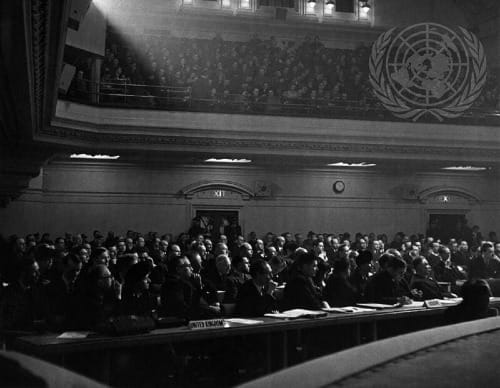Beyond the Chimaera: International Organizations' Drive to Survive

Share
On the 18th of October, NATO Defense Ministers held a meeting where they reiterated that strengthening deterrence was going to remain their top priority. This spurred a question: what if the Russia-Ukraine war had not happened? What if somehow there had been a European – Russian agreement and a solution had been worked out? Would NATO have admitted at that point that its relevance had been reduced? The quick answer is that it probably would have identified another challenge as a necessity requiring constant vigilance and an ever prepared and financed NATO.
This spurred questions that I had asked myself over the course of my diplomatic career, but that I had not given due consideration: how much of a survival drive do international organizations, once they are formed, have? Do they, as entities distinct from their member states, have independent drives to remain relevant? Do they seek relevance beyond the initial reason for their founding?
These questions come at a time of considerable change on the global stage. With the UN scrambling to align with an evolving global order, with NATO expanding its membership, and new blocs like BRICS forming, I think it is important to differentiate between adaptable organizations and those that justify their existence by perpetuating the conditions that necessitated their establishment in the first place.
There is an important balance to be found between maintaining and adapting existing organizations to meet new needs, in order to leverage continuity, institutional memory, and expertise on the one hand, and identifying organizational behavior geared towards self-justification of continued existence.
Organizational Drive to Survive

Organizations are established in response needs. The United Nations was established to prevent a recurrence of the horrors of the second world war. NATO was created to counter the threat of Soviet encroachment, the World Bank was founded to rebuild war torn Europe, and the Organization of African Unity (which became the African Union) was created to foster development and freedom from colonialism on the continent.
Once created, and as their structures take form through secretariats, bureaucracies, and agencies, international organizations become distinct entities from the governments that set them up. With their own teams, staff, and institutional identity, they develop intraorganizational cultures forged through their internal mechanisms. Once these structures solidify, the sense of organizational self-preservation develops over time, progressively becoming stronger.
At the early stages of an organization’s inception, its legitimacy stems from achieving progress on the goals for which it was founded. The clarity of purpose that guides the direction of an organization during the early years provides enough cause for its existence without the need for further justifications. With the progressive achievement of targets however, the reasons for an organization’s continued existence may no longer be as evident as they were at its founding. As goals are achieved, and targets fulfilled, justifying continued existence becomes imperative; either the organization can support its continued demand for allocation of resources, or it may find itself waning in relevance, facing dissolution or even replacement.
Consider for example the case of NATO, which in the 1990s rebranded its strategic objectives to maintain relevance (which it did several times subsequently, most recently in 2022 naming Russia as its latest rival); with the dissolution of the USSR, it had to pivot to other threats, or the case of the Organization of African Unity that during the same period rebranded into the African Union, shifting its priorities from decolonialization to sustainable development, and continental security.
In these examples, organizations, rebrand, reprioritize, and reframe their institutional focus to ensure their survival. They reinvent new roles for themselves, expand on old ones, or redefine challenges to ensure that they continue to receive the support and resources they need. This drive to survive can foster adaptability on an organizational level, and incentivize agility to address emerging threats or challenges, but it can also encourage prioritizing the organization itself over the goals or the member states’ interests.
It is at this intersect that the problem lies; an agile adaptable organization is a net positive for its member states, but an organization that shifts toward prioritizing its own survival over the goals of its members can become a burden on those it purportedly was established to serve.
Walking the Tightrope Between Adaptability and Survivalism

As international organizations become more complex, and their roles more integrated with other regional and international mechanisms, identifying the continued relevance of an organization is critically important. Being able to differentiate between an organization that has adapted to meet evolving challenges versus one that is attempting to justify its unchanged role by reinterpreting the reality around it is crucial. The former is constructive while the latter is potentially destructive.
It is not a simple solution however. To broadly state that any organization that has achieved its goals should be dissolved, is to lose sight of the forest for the trees; in many cases it is actually constructive to reshape the focus and priorities rather than disband, for a number of reasons. It takes time and effort to build institutional foundations and infrastructures, and to use them for a singular purpose and then disband them would be similar to buying a laptop to write a few papers and then throwing the laptop away, only to buy a new one the next time you need to perform a similar task.
This ventures into ‘sunk costs’ territory; refusing to dissolve an organization only because a lot of investment has gone into it is an expensive logical fallacy, while maintaining an organization only because it would be unpleasant to disband it is the other side of the same coin. This brings us to the crux of the matter: distinguishing between an organization that adapts to face a changing environment, and one that seeks to reframe its environment to justify its continued existence.
To illustrate the difference, consider an example of a European country that is both member of the EU and NATO. It is late 2021, and the situation in Ukraine is escalating. The country has two scenarios presented before it, one through the lens of NATO, a defense alliance that has as its primary raison d’etre joint defense, and the other through the perspective of the EU an organization with a broader scopes of engagement.
NATO presents the case that Russia poses a security threat, and therefore can only be engaged through that perspective. NATO pays lip service to dialogue with Russia on various occasions, while in the same breath refuses to compromise on any of its positions that have been flagged by Russia as concerns (primarily that Ukraine should not join NATO), and adopted an overtly adversarial tone. By leveraging US intelligence on Russian movements, it had to magnify the problem in the eyes of its members to ensure that it, not any other agency, would be the primary go to for engagement with Russia.
Through the perspective offered by NATO, confrontation with Russia was a fait accompli, an inevitability and it accordingly fostered an environment whereby any other form of engagement -negotiation, cooperation, etc.- could be framed as appeasement of Russia and detrimental to Europe’s security. Accordingly, it encouraged rapid engagement, unwavering support for Ukraine, uncompromising positions vis a vis Russia, and deterrence through a show of force.
In so doing, in framing engagement with Russia as appeasement and framing those who supported a more cooperative approach as undermining the collective security of Europe, it effectively -albeit indirectly- denied its members the opportunity to resort to alternative agencies and modes of engagement. The EU approach for instance could have been more holistic in its approach, adopting a balance between proactive positive engagement and deterrence, leveraging the growing mutual interests between the two sides as a carrot for engagement, and the potential for conflict as a stick for deterrence. Germany and France had an opportunity to lead this euro centric approach, but found it difficult due to the framing of the context.
In this example, if NATO had not scrambled to ensure that the situation was framed and engaged on from a purely security and defense perspective, it would have found its own relevance as an organization waning. A euro centric approach, leveraging the European defense agency and strategy instead of NATO’s, and contextualizing the challenge within a broader web of regional and continental strategies geared towards stability rather than adversariality, NATO would have been sidelined.
Therefore, for its own continued relevance and for its long term survival, it was imperative for NATO to ensure that the challenge was framed from a security perspective. From an organizational perspective, it was a matter of continued relevance for NATO, and it approached it as such.
This example illustrates how an organization, when allowed to frame challenges in the manner that most suits its own priorities rather than those of its member states, will likely adopt whatever approach ensures its own survival. In this case, rather than adapt the organization to the needs of its members, it reframed reality in the interest of its own perpetuation.
Whether or not the European-NATO response was the correct one remains debatable, the issue here is that other approaches were not considered because the tunnel vision imposed by the security lens made it untenable for states to propose alternatives within the context.
The outcome of this case is powerfully evocative; if international organizations are allowed to take the lead rather than being led by the priorities of their members, policy directions may end up serving the interests of the organizations instead of the states that founded it.
Reigning in Organizations: A Balancing Act

NATO is not the only organization that adopts this pattern of behavior, others in the security sector on the governmental and intergovernmental levels follow similar trends; when all you have is a hammer, every problem looks like a nail. This tendency is not limited to defense alliances however. Development banks and international financial institutions, such as the World Bank, demonstrate similar behavior, adapting their mandates to retain influence. Just as as NATO redefined its purpose in a post-Cold War world, development banks often adjust their strategies to address new challenges, while ensuring that their roles remain essential to the countries they serve
Whether in the field of security or economic development, the underlying drive remains the same: organizations with established identities seek to ensure their own survival. NATO’s framing of the Russia-Ukraine conflict is mirrored by the World Bank’s (and its associated organizations) approach to global poverty and development, where the need for continued intervention justifies the organization’s ongoing role.
Expecting an organization to declare its own obsolescence is unrealistic. Just as an individual is unlikely to suggest eliminating their own job, organizations will rarely advocate for their own dissolution. This makes it crucial that independent oversight mechanisms are prevalent across the board of international organizations. Rather than exclusively relying on the organization itself to advocate for its own continued relevance, balancing self-evaluations with an independent perspective will provide the necessary outlook to determine the status of the organization.
From there, member states can make more informed decisions on the role of their organizations, on whether to maintain them in the same form that they are, to redesign and reallocated resources, or to restructure them to face new and emerging challenges. Whatever the course of action is, there has to be a balance between the perspective driven by the survival drive of the organization and the actual need for its presence.
Adopting a broader perspective will help balance between falling into the sunk costs fallacy and reaping the benefits of continuity and institutional memory. It will also help determine the validity of resource allocation, with the direction of collective policies driven by the needs of member states rather than guided by the interests of the organizations themselves.
While it remains necessary to consider the perspective of the organization itself -it represents a collective consciousness of its members that balances between their varying perspectives-, it is also important not to allow it to take precedence over the interests of its members or the achievement of the goal for which it was established. The purpose of an international organization should be to fulfil a need, not ensure its own survival.
Like Bellerophon who always sought out the Chimaera, an organization tasked with addressing challenges will always find one to justify its existence.
